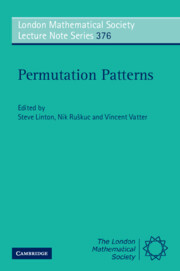Book contents
- Frontmatter
- Contents
- Preface
- Some general results in combinatorial enumeration
- A survey of simple permutations
- Permuting machines and permutation patterns
- On three different notions of monotone subsequences
- A survey on partially ordered patterns
- Generalized permutation patterns – a short survey
- An introduction to structural methods in permutation patterns
- Combinatorial properties of permutation tableaux
- Enumeration schemes for words avoiding permutations
- The lexicographic first occurrence of a I-II-III-pattern
- Enumeration of partitions by rises, levels and descents
- Restricted patience sorting and barred pattern avoidance
- Permutations with k-regular descent patterns
- Packing rates of measures and a conjecture for the packing density of 2413
- On the permutational power of token passing networks
- Problems and conjectures
- References
Generalized permutation patterns – a short survey
Published online by Cambridge University Press: 05 October 2010
- Frontmatter
- Contents
- Preface
- Some general results in combinatorial enumeration
- A survey of simple permutations
- Permuting machines and permutation patterns
- On three different notions of monotone subsequences
- A survey on partially ordered patterns
- Generalized permutation patterns – a short survey
- An introduction to structural methods in permutation patterns
- Combinatorial properties of permutation tableaux
- Enumeration schemes for words avoiding permutations
- The lexicographic first occurrence of a I-II-III-pattern
- Enumeration of partitions by rises, levels and descents
- Restricted patience sorting and barred pattern avoidance
- Permutations with k-regular descent patterns
- Packing rates of measures and a conjecture for the packing density of 2413
- On the permutational power of token passing networks
- Problems and conjectures
- References
Summary
Abstract
An occurrence of a classical pattern p in a permutation π is a subsequence of π whose letters are in the same relative order (of size) as those in p. In an occurrence of a generalized pattern some letters of that subsequence may be required to be adjacent in the permutation. Subsets of permutations characterized by the avoidance–or the prescribed number of occurrences–of generalized patterns exhibit connections to an enormous variety of other combinatorial structures, some of them apparently deep. We give a short overview of the state of the art for generalized patterns.
Introduction
Patterns in permutations have been studied sporadically, often implicitly, for over a century, but in the last two decades this area has grown explosively, with several hundred published papers. As seems to be the case with most things in enumerative combinatorics, some instances of permutation patterns can be found already in MacMahon's classical book from 1915, Combinatory Analysis. In the seminal paper Restricted permutations of Simion and Schmidt from 1985 the systematic study of permutation patterns was launched, and it now seems clear that this field will continue growing for a long time to come, due to its plethora of problems that range from the easy to the seemingly impossible, with a rich middle ground of challenging but solvable problems.
Information
- Type
- Chapter
- Information
- Permutation Patterns , pp. 137 - 152Publisher: Cambridge University PressPrint publication year: 2010
References
Accessibility standard: Unknown
Why this information is here
This section outlines the accessibility features of this content - including support for screen readers, full keyboard navigation and high-contrast display options. This may not be relevant for you.Accessibility Information
- 5
- Cited by
